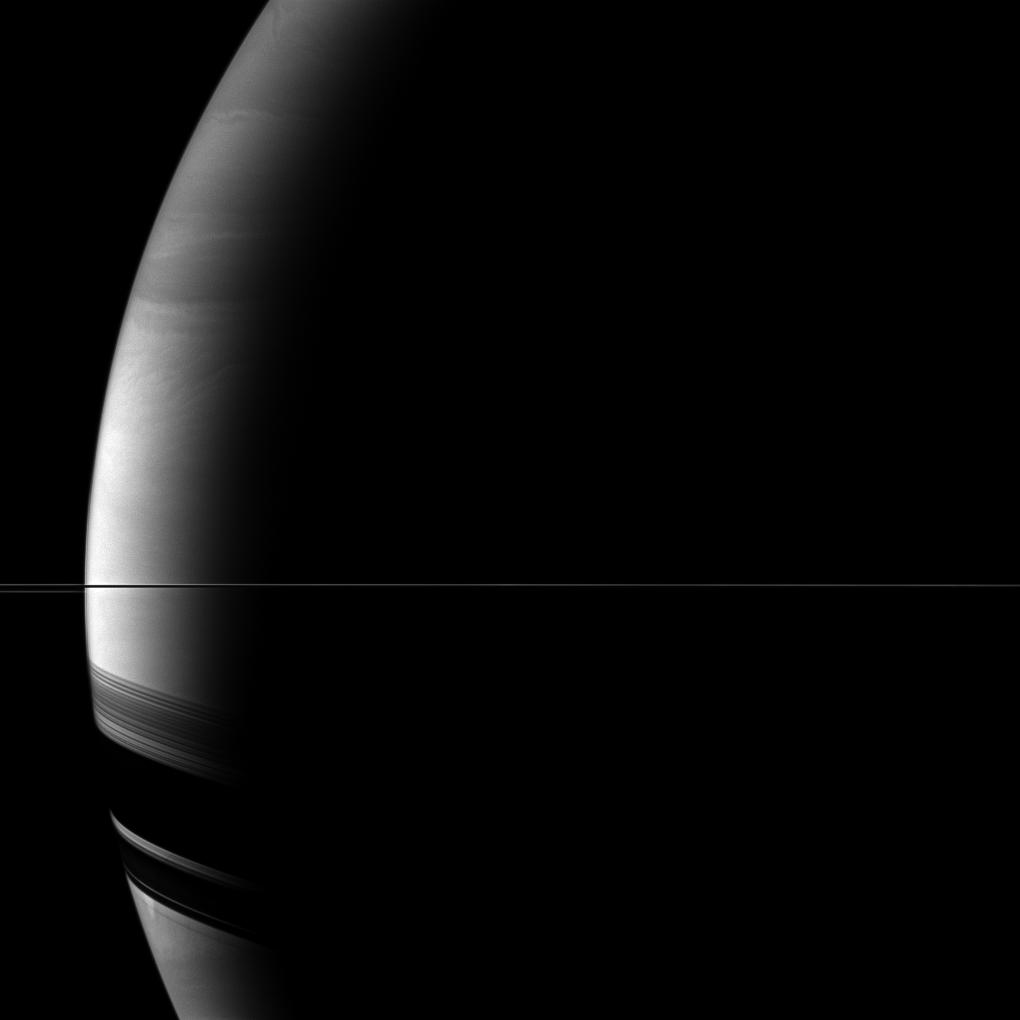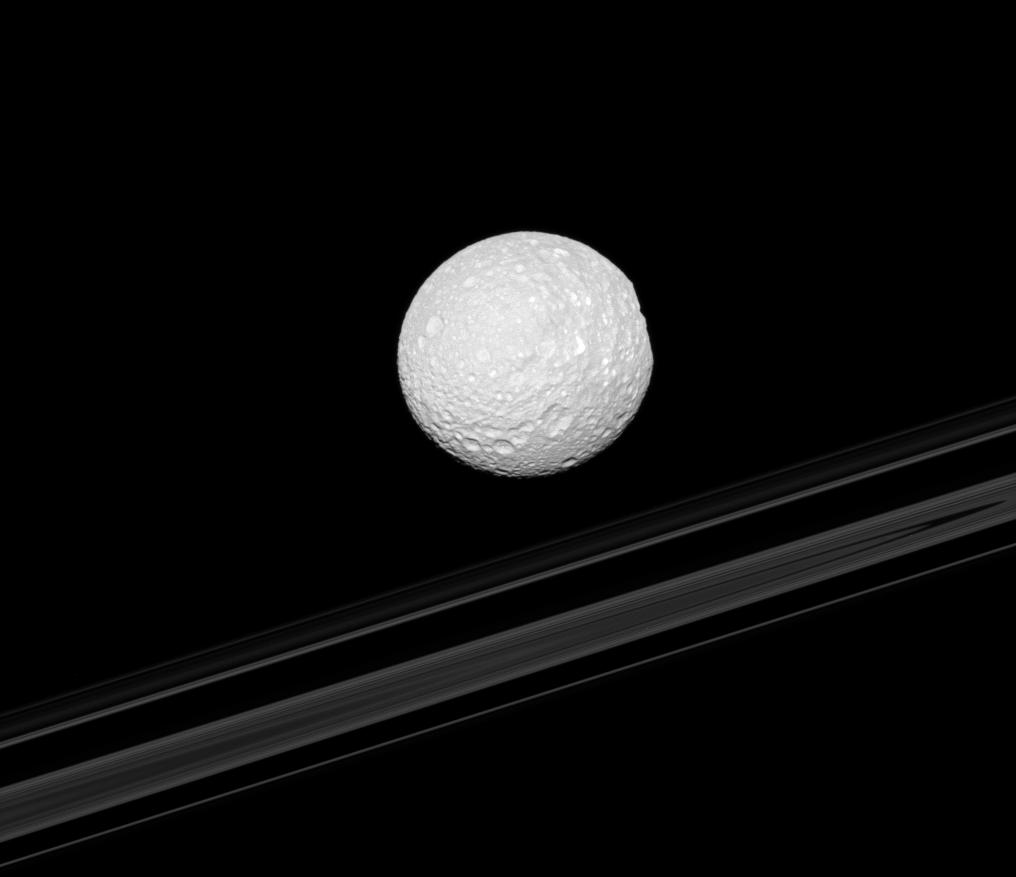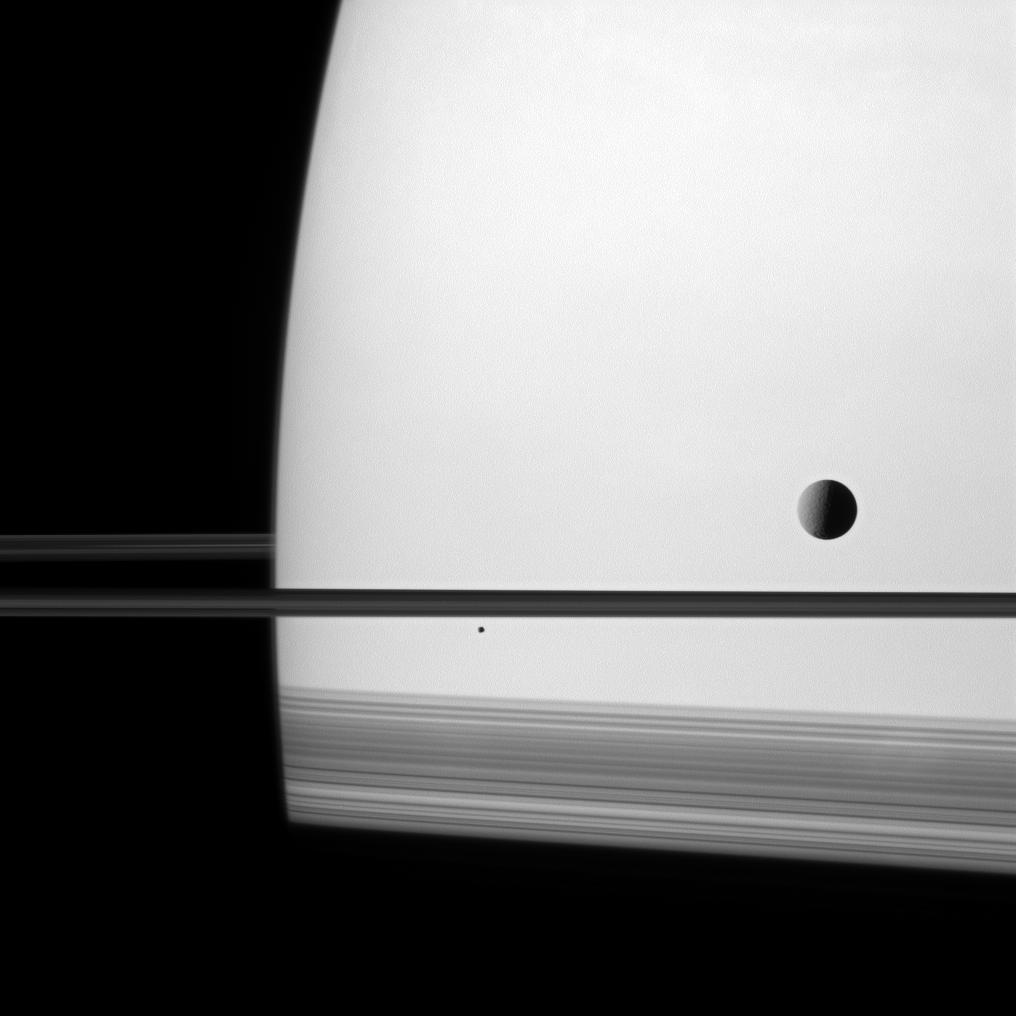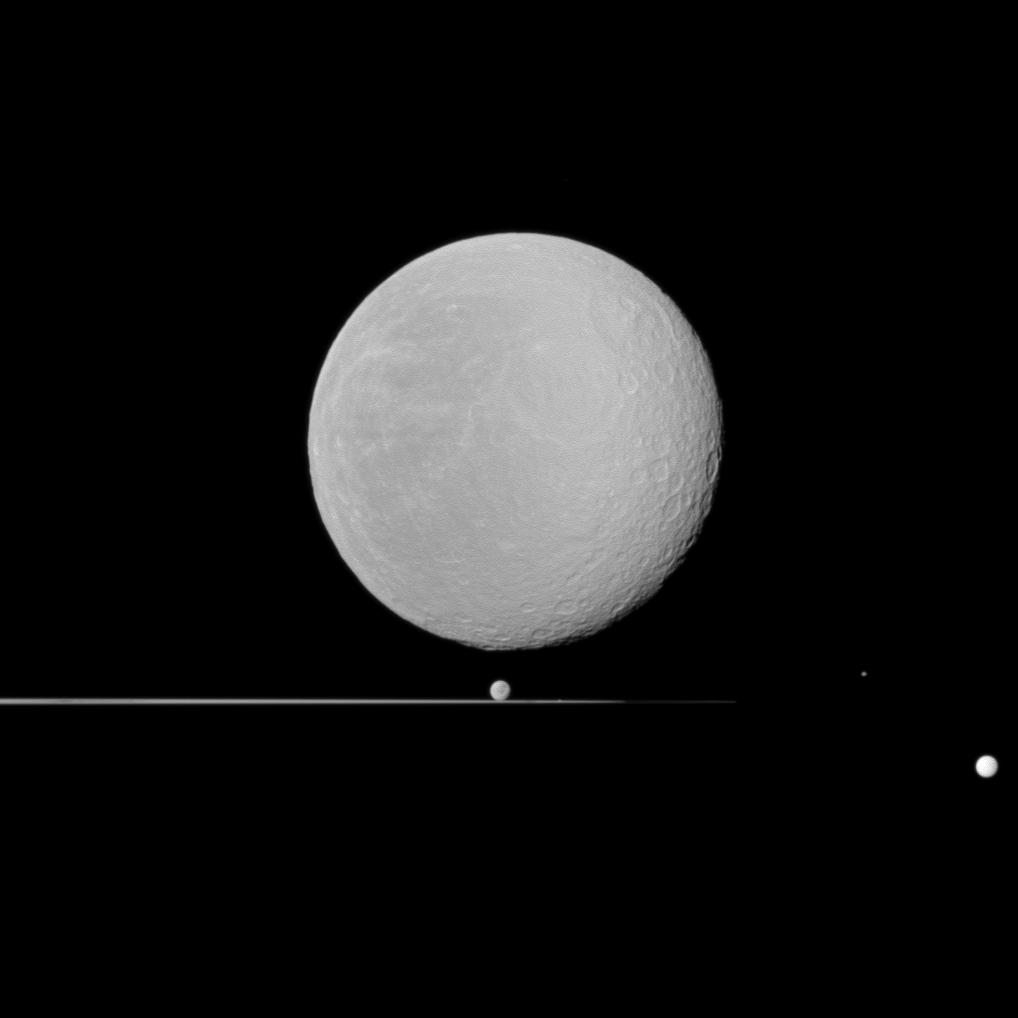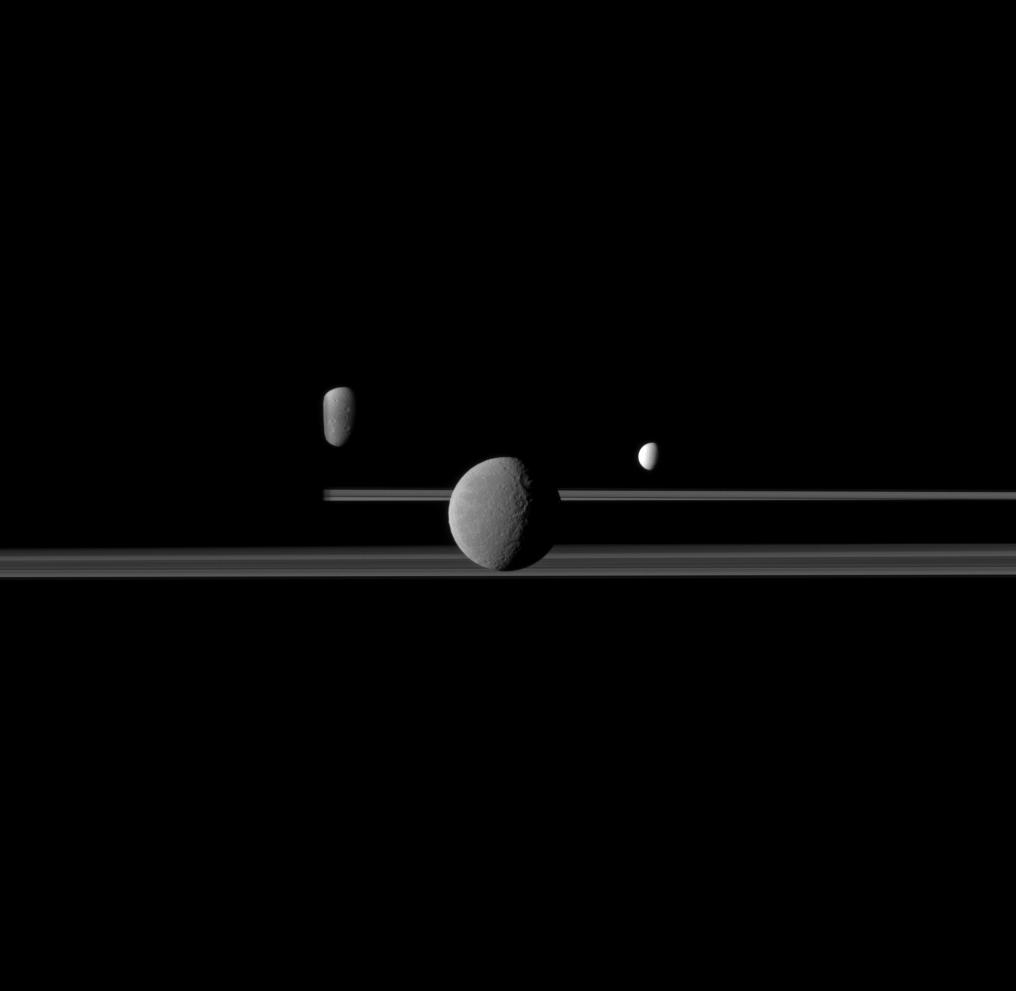Saturn's Neighborhood
Re: Saturn's Neighborhood
Know the quiet place within your heart and touch the rainbow of possibility; be
alive to the gentle breeze of communication, and please stop being such a jerk. — Garrison Keillor
alive to the gentle breeze of communication, and please stop being such a jerk. — Garrison Keillor
Re: Saturn's Neighborhood
Thin Line, Broad Shadows
Cassini Solstice Mission | 2011 Feb 21
Saturn's rings appear as only a thin line seen edge-on in the middle of this Cassini view, but the rings cast broad shadows on the southern hemisphere of the planet in the lower left of the image.
This view looks toward the southern, unilluminated side of the rings from just below the ringplane.
The image was taken with the Cassini spacecraft wide-angle camera on Jan. 9, 2011 using a spectral filter sensitive to wavelengths of near-infrared light centered at 728 nanometers. The view was acquired at a distance of approximately 796,000 kilometers (494,000 miles) from Saturn and at a Sun-Saturn-spacecraft, or phase, angle of 147 degrees. Image scale is 44 kilometers (27 miles) per pixel.
Credit: NASA/JPL/SSI
Know the quiet place within your heart and touch the rainbow of possibility; be
alive to the gentle breeze of communication, and please stop being such a jerk. — Garrison Keillor
alive to the gentle breeze of communication, and please stop being such a jerk. — Garrison Keillor
Re: Saturn's Neighborhood
Know the quiet place within your heart and touch the rainbow of possibility; be
alive to the gentle breeze of communication, and please stop being such a jerk. — Garrison Keillor
alive to the gentle breeze of communication, and please stop being such a jerk. — Garrison Keillor
Saturn's Neighborhood: Mimas
Mimas' Flat Spot
NASA JPL-Caltech | Cassini Solstice Mission | 2011 Apr 11
NASA JPL-Caltech | Cassini Solstice Mission | 2011 Apr 11
The right-hand limb of Saturn's moon Mimas appears flattened as Herschel Crater is viewed edge-on in this Cassini spacecraft image. The planet's rings are in the background.
Herschel Crater is 130 kilometers (81 miles) wide and located on the moon's leading hemisphere. See Examining Herschel Crater for a straight-on view of the crater.
This view looks toward the anti-Saturn side of Mimas (396 kilometers, or 246 miles across). North on Mimas is up and rotated 16 degrees to the left. This view looks toward the southern, unilluminated side of the rings from just below the ringplane.
The image was taken in visible light with the Cassini spacecraft narrow-angle camera on Jan. 31, 2011. The view was acquired at a distance of approximately 260,000 kilometers (161,000 miles) from Mimas and at a Sun-Mimas-spacecraft, or phase, angle of 9 degrees. Image scale is 2 kilometers (1 mile) per pixel.
Credit: NASA/JPL/SSI
Know the quiet place within your heart and touch the rainbow of possibility; be
alive to the gentle breeze of communication, and please stop being such a jerk. — Garrison Keillor
alive to the gentle breeze of communication, and please stop being such a jerk. — Garrison Keillor
Saturn's Neighborhood: Tethys & Epimetheus
Cut Off by Shadows
NASA JPL-Caltech Cassini | 2011 Apr 25
NASA JPL-Caltech Cassini | 2011 Apr 25
Shadows cast by Saturn's rings darken the southern hemisphere of the planet and give a truncated appearance to the bottom of this Cassini spacecraft image.
Saturn's moon Tethys (1,062 kilometers, or 660 miles across) is part of this scene on the right. The smaller moon Epimetheus (113 kilometers, or 70 miles across) completes this composition and can be seen below the center of the image.
This view looks toward the northern, sunlit side of the rings from just above the ringplane. Lit terrain seen on Tethys is on the area between the trailing hemisphere and anti-Saturn side of the moon.
The image was taken with the Cassini spacecraft narrow-angle camera on March 8, 2011 using a spectral filter sensitive to wavelengths of visible red light centered at 619 nanometers. The view was obtained at a distance of approximately 3.2 million kilometers (2 million miles) from Saturn and at a Sun-Saturn-spacecraft, or phase, angle of 87 degrees. Scale on Saturn is 19 kilometers (12 miles) per pixel.
Credit: NASA/JPL/SSI
Know the quiet place within your heart and touch the rainbow of possibility; be
alive to the gentle breeze of communication, and please stop being such a jerk. — Garrison Keillor
alive to the gentle breeze of communication, and please stop being such a jerk. — Garrison Keillor
Re: Saturn's Neighborhood
Whoa, really astonishing. I'm new here and i have the impression that everyone here has the knowledge of a NASA-scientist...
Re: Saturn's Neighborhood
starship, welcome to Asterisk! I freely admit I do not have the knowledge of a NASA scientist. I do know a number of NASA scientists, though; does that count? 
A closed mouth gathers no foot.
- geckzilla
- Ocular Digitator
- Posts: 9180
- Joined: Wed Sep 12, 2007 12:42 pm
- Location: Modesto, CA
- Contact:
Re: Saturn's Neighborhood
I have the power to put quote tags around things that NASA scientists say. Does that count?
Just call me "geck" because "zilla" is like a last name.
Re: Saturn's Neighborhood
@ owlice & geckzilla
cheers dudes, I reckon both count
cheers dudes, I reckon both count
Re: Saturn's Neighborhood
Welcome Starship.
Hang around this Spaceport long enough, and you too will soak up enough knowledge to feel smart enough to join conversations. You've already proven yourself intelligent enough to speak up, ask questions, and ponder the cosmos
Hang around this Spaceport long enough, and you too will soak up enough knowledge to feel smart enough to join conversations. You've already proven yourself intelligent enough to speak up, ask questions, and ponder the cosmos
Saturn's Neighborhood: Five Orbs
Five Orbs
NASA JPL-Caltech Cassini | 2011 May 23
NASA JPL-Caltech Cassini | 2011 May 23
Five moons -- dominated by Rhea in the foreground -- share this Cassini spacecraft view with Saturn's rings seen nearly edge-on.
Rhea (1,528 kilometers, or 949 miles across) is largest here and is closest to Cassini. Dione (1,123 kilometers, or 698 miles across) can be seen just above the rings near the center of the image. Tiny Prometheus (86 kilometers, or 53 miles across) is just barely visible in the rings to the right of Dione. Epimetheus (113 kilometers, or 70 miles across) is to the right of the rings, and Tethys (1,062 kilometers, or 660 miles across) is on the extreme right of the image.
This view looks toward the anti-Saturn side of Rhea and toward the northern, sunlit side of the rings from just above the ringplane.
The image was taken in visible light with the Cassini spacecraft wide-angle camera on Jan. 11, 2011. The view was obtained at a distance of approximately 61,000 kilometers (38,000 miles) from Rhea and at a Sun-Rhea-spacecraft, or phase, angle of 15 degrees. Scale on Rhea is 4 kilometers (2 miles) per pixel.
Credit: NASA/JPL/SSI
Know the quiet place within your heart and touch the rainbow of possibility; be
alive to the gentle breeze of communication, and please stop being such a jerk. — Garrison Keillor
alive to the gentle breeze of communication, and please stop being such a jerk. — Garrison Keillor
Saturn's Neighborhood: Bright Moons, Dark Planet
Bright Moons, Dark Planet
NASA JPL-Caltech Cassini | 2011 Jun 20
NASA JPL-Caltech Cassini | 2011 Jun 20
The Cassini spacecraft observes three of Saturn's moons set against the darkened night side of the planet.
Saturn is present on the left this image but is too dark to see. Rhea (1,528 kilometers, or 949 miles across) is closest to Cassini here and appears largest at the center of the image. Enceladus (504 kilometers, or 313 miles across) is to the right of Rhea. Dione (1,123 kilometers, or 698 miles across) is to the left of Rhea, partly obscured by Saturn.
This view looks toward the northern, sunlit side of the rings from just above the ringplane.
The image was taken in visible red light with the Cassini spacecraft narrow-angle camera on April 25, 2011. The view was obtained at a distance of approximately 2.2 million kilometers (1.4 million miles) from Rhea and at a Sun-Rhea-spacecraft, or phase, angle of 67 degrees. Image scale is 13 kilometers (8 miles) per pixel on Rhea. The view was obtained at a distance of approximately 3 million kilometers (1.9 million miles) from Enceladus and at a phase angle of 67 degrees. Image scale is 18 kilometers (11 miles) per pixel on Enceladus. The view was obtained at a distance of approximately 3.1 million kilometers (1.9 million miles) from Dione and at a phase angle of 67 degrees. Image scale is 19 kilometers (12 miles) per pixel on Dione.
Credit: NASA/JPL/SSI
Know the quiet place within your heart and touch the rainbow of possibility; be
alive to the gentle breeze of communication, and please stop being such a jerk. — Garrison Keillor
alive to the gentle breeze of communication, and please stop being such a jerk. — Garrison Keillor
Saturn's Neighborhood: Five Moons for Cassini
Pretty picture: five moons for Cassini
Planetary Society | Emily Lakdawalla | 2011 Aug 03
Planetary Society | Emily Lakdawalla | 2011 Aug 03
Cassini caught a particularly nice grouping of moons two days ago through the red, green, and blue filters needed to make a natural color view. A couple of other sites have posted this image already but I couldn't resist making my own color version. There are five moons here (left to right): Janus, Pandora, Enceladus, Mimas, and Rhea.
When I see groupings like this I wonder: just how precisely did they need to time their capturing of this photo, in order to catch all five moons? And would it have been possible to get it with Rhea entirely within the frame? ... the three moons on the left are on the far side of Saturn from Cassini and moving to the left, while the two moons on the right are nearer to Cassini than Saturn and are moving to the right.
Of course there wasn't a single "moment" when Cassini snapped the color photo; it took the original red, green, and blue images one after the other. That always makes the task of composing color views challenging. Here's an intermediate step in the processing, in which I'd aligned the rings with each other, but not yet the moons:
To finish the images, I had to do some cutting and pasting to align everything -- I picked the position that everything occupied in the first, red-filter image, because the moons were clustered more tightly and because that way there would be less fudging of the rings involved. It was easy to line up Janus and Enceladus -- just cut out and move the green and blue images until they lined up with the red one. Pandora was slightly harder, because when you cut out Pandora you're also cutting some rings; I had to take bits of rings from elsewhere to fill in the gaps left behind. The most challenging was Mimas and Rhea because of their overlap and because there was less of Rhea available in blue and green filters than there was in the red filter. I could have chosen to crop the image where Rhea ended in the blue filter but I wanted to preserve a view of more of Rhea, so I fudged that by filling the gaps in Rhea coverage in green and blue filters with a strip of data from the red-filter image, adjusting its brightness to match the appearance of Rhea in the other two filters. It works fine because that strip lies near the terminator (day-night boundary) where variation across Rhea has more to do with light-and-dark shading from topography than it does with any color changes there may be across Rhea's surface.
One thing that didn't take much work is the color. Often with Cassini images there's a subjective step in which you have to adjust the levels of the different channels to make the colors look right. But whenever there is a color composite containing both black space and Enceladus, getting the colors right is easy. Black space is black; Enceladus is pretty darn close to white. The automatic contrast stretch applied to the raw images doesn't actually do any stretching (or, at least, doesn't stretch the different-color channels in different ways) when there's a lot of black and white pixels already in the photo. So the rest of the colors come out pretty close to true.
Know the quiet place within your heart and touch the rainbow of possibility; be
alive to the gentle breeze of communication, and please stop being such a jerk. — Garrison Keillor
alive to the gentle breeze of communication, and please stop being such a jerk. — Garrison Keillor
Re: Saturn's Neighborhood
These images are truly spectacular!
Thnak you very much.
Thnak you very much.
